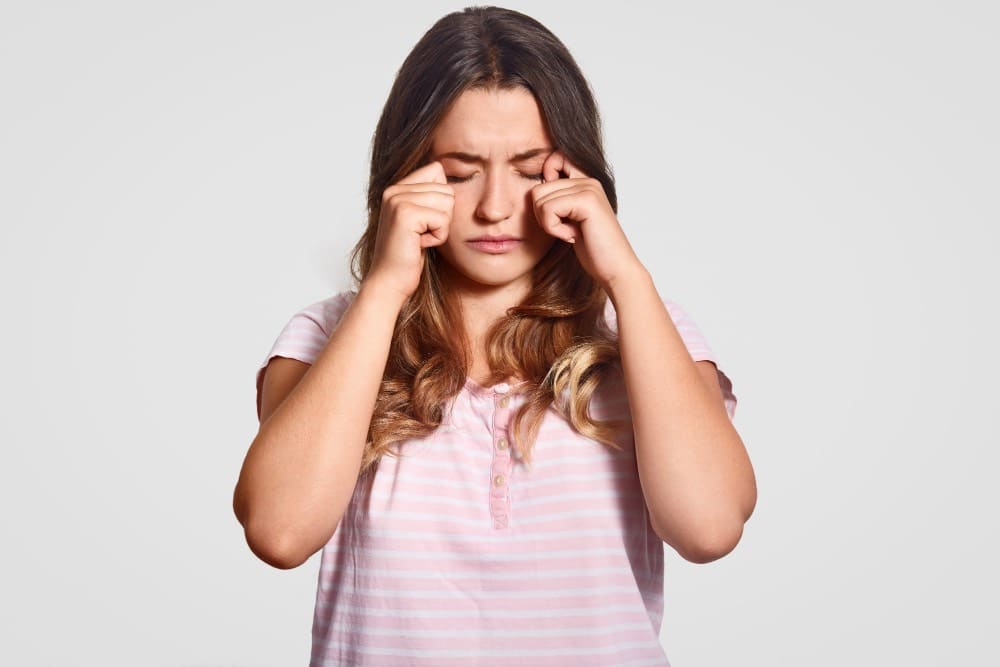Scientifically proven technology for the treatment of Meibomian Gland Dysfunction
Looking for longer-lasting treatment for Dry Eyes?
Dry Eye Disease is one of the most common eye diseases in the world due to an aging population and changes to our modern-day lifestyle. Almost 1 in 5 people experience dry eye syndrome, where the eyes are stinging, scratchy, reddened, and feel as if filled with sand.
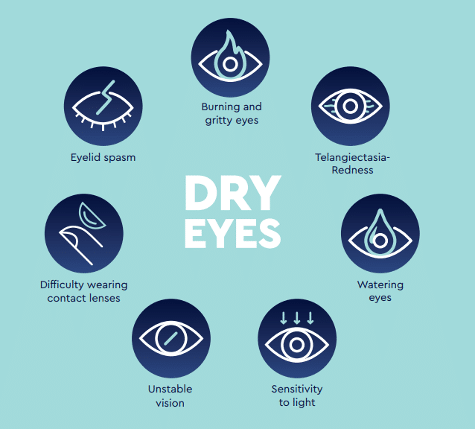
Risk Factors
- Heavy use of screens
- Contact Lens Wear
- Dry Environments
- Air conditioning
- Aging
- Sex (Females are more prone)
- Race (Asian race is most prone)
- Allergies and infections
- Eye surgeries
- Some medications
- Hormonal imbalances
IPL: A Long Lasting Treatment For Meibomian Gland Dysfunction
Around 86% of Dry Eye Disease cases are due to Meibomian Gland Dysfunction.
There are 60-80 Meibomian Glands located in the upper and lower eyelids. These glands produce an oil layer that coats the tear film which protect the eyes from tear evaporation. Dysfunction occurs when the glands start to degenerate, and the tear layer becomes disrupted and eyes become dry. If left untreated, the discomfort from dry eye can become permanent, and wearing contact lenses often becomes impossible.
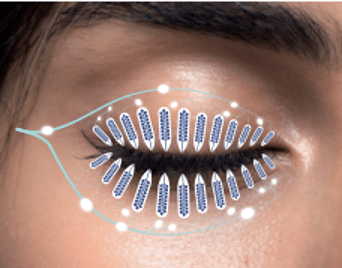
The E>Eye Medical Grade IPL device is specifically designed for the treatment of dry eye syndrome due to the Meibomian Gland Dysfunction. It is a long-term treatment which stimulates and regenerates damaged oil glands.
The results of several independent international E>Eye-studies speak for themselves:
- 96% Recommend the Treatment
- 83% Confirm Improvement of Symptoms
- 55% Stop Using Eye-Drops After The Treatment
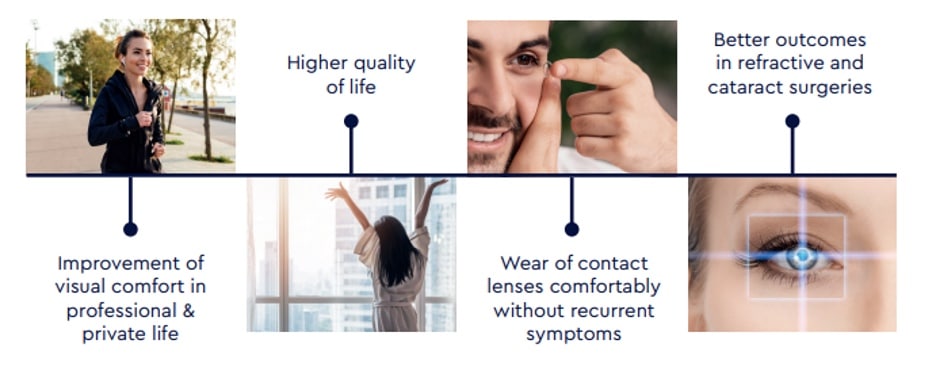
Patients with well-managed Dry Eyes enjoy a higher quality of life with improved visual comfort in their professional and private lives. Patients also experience greater comfort in wearing contact lenses without recurring symptoms. Additionally, treatment of Dry Eye Disease is a major prerequisite to refractive and cataract surgeries, for improved post-surgical outcomes in terms of safety, comfort and quality of vision.
IPL Treatment Procedure
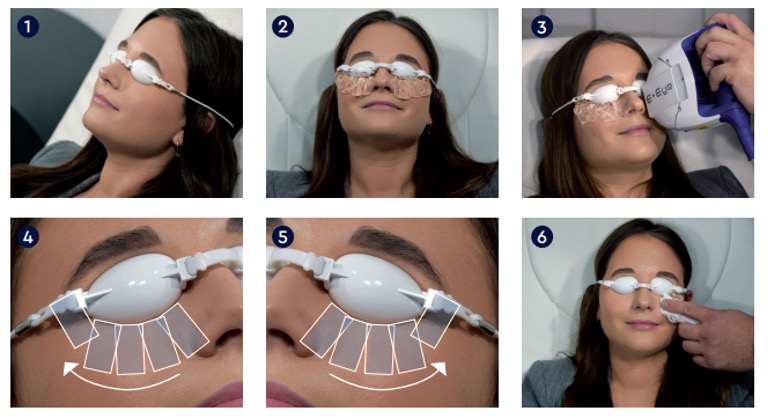
Source: Eyetek (2023)
- Sitting in a comfortable chair, your eyes are covered by protective eyecups.
- Hydrogel is applied to the area around the lower eyelid to protect the skin.
- A series of light pulses are performed around the lower eye; gentle and non-invasive.
4-5. The series is repeated in the same way for both eyes.
- The Hydrogel is gently cleansed off the face.
- Our Optometrist performs professional Meibomian gland expression (double expression of lower and upper lids)
- Gentle cleansing of the eye and lids using a saline rinse and an anti-bacterial lid cleansing scrub
- Instillation of anti-bacterial eye gel to improve corneal quality
Treatment duration: 45mins

Source: Eyetek (2023)
The treatment restores the normal activity of the Meibomian gland.
- The effect of first two treatments lasts a few days up to 2 to 3 weeks.
- The long-lasting effect is expected for minimum 6 months up to 3 years.
- In 60% of cases, effects persist beyond 3 years after the treatment.
- We recommend an E>Eye treatment protocol of four sessions.
- It is recommended to repeat one application once symptoms are coming back.
Grace & Vision Optometrist is proud to be one of the first optometrists in Brisbane to provide IPL treatment, and we are equipped with extensive experiences in dry eye treatments.
The Science Behind IPL
Dry Eye Disease, which can arise from multiple factors, starts off with tear film instability that is accompanied by increased tear osmolarity. This activates stress signalling pathways in the ocular surface and immune cells, which triggers production of inflammatory molecules. These then initiate a vicious self-repeating cycle that may lead to further deterioration in tear function and worsening of symptoms.
The E>Eye IPL technology generates perfectly calibrated and homogeneously sequenced light pulses. The energy, spectrum and time period are precisely set to stimulate the Meibomian glands in order for them to return their normal function.
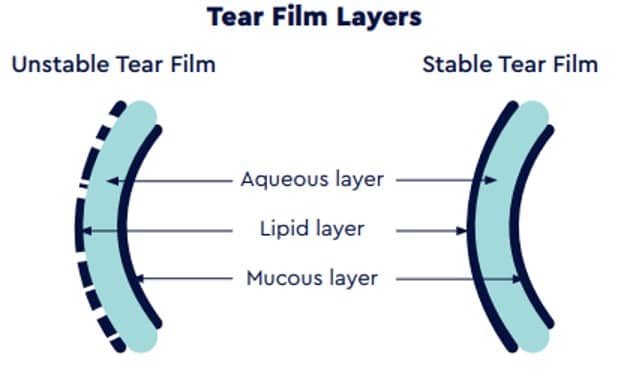
Source: Eyetek (2023)
The flashes emitted are directed to the parasympathetic nerve that supplies the Meibomian Glands. The neurotransmitters released then interact with the glands to stimulate secretion. As such, E>Eye does not directly affect the Meibomian glands. Rather, its action is indirect, where the “flashed” areas (underneath the eyelid) are the areas where the parasympathetic nerve passes.
The results are:
- Regeneration of the Meibomian Glands
- Improved quality of the glandular secretions
- Stabilized lipid layer of the tear film
Additionally, the following effects have been proposed to explain the clinical benefits observed with IPL:
- Warming and liquifying effect, facilitating meibum expression following IPL treatment
- Photo-modulation stimulating mitochondria of Meibomian Glands, also enhancing collagen synthesis
- Vascular thrombosis aiding in decrease in inflammation
- Anti-bacterial and anti-parasitic effects
- Connective tissue rejuvenation with fibroblast–collagen synthesis and remodelling reducing eyelid- epithelial turnover and decreasing gland obstruction.
Reduce your Dry Eye irritation and frustration.
Talk to one of our optometrists about finding a dry eye solution tailored for you.
Sources:
- Dr Malbrel. Polychromatic pulsed light device for a dysfunction described as “dry eye”
- Peking Third University Hospital. Evaluation of the safety and effectiveness of the controlled discharge xenon flash lamp
- Official publication in “Journal of Ophthalmology” of Dr Li. Evaluation of the Safety and Effectiveness of Intense Pulsed Light
- Fondation A de Rothschild and Hôpital Bichat. Efficacy of Intense Regulated Pulsed Light Therapy
- Jiang, X. Research Article Evaluation of the Safety and Effectiveness of Intense Pulsed Light in the Treatment of Meibomian Gland Dysfunction
- S Egri. Efficacy of intense pulsed light therapy in the treatment of Meibomian gland dysfunction-related severe dry eye
- Jennifer P. Craig, Chen, Y.-H., & Turnbull, P. R. K. Prospective trial of intense pulsed light for the treatment of meibomian gland dysfunction
- Carones Ophthalmology Center. Ocular Surface Workup in Patients with Meibomian Gland Dysfunction Treated with Intense Regulated Pulsed Light
- Julie M Albietz, Katrina L Schmid. Intense pulsed light treatment and meibomian gland expression for moderate to advanced meibomian gland dysfunction
- Özgün Melike Gedar Totuk. Efficacy of Intense Pulsed Light Treatment for Moderate to Severe Acute Blepharitis or Blepharoconjunctivitis: A Retrospective Case Series (DOI: 10.4274/tjo.galenos.2020.28924)
- Luca Vigo. Ocular Surface Workup in Patients with Meibomian Gland Dysfunction Treated with Intense Regulated Pulsed Light (DOI: 10.3390/diagnostics9040147)
- Jennifer P. Craig. Randomised double-masked placebo-controlled trial of the cumulative treatment efficacy profile of intense pulsed light therapy for meibomian gland dysfunction (DOI: 10.1016/j.jtos.2020.01.003)
